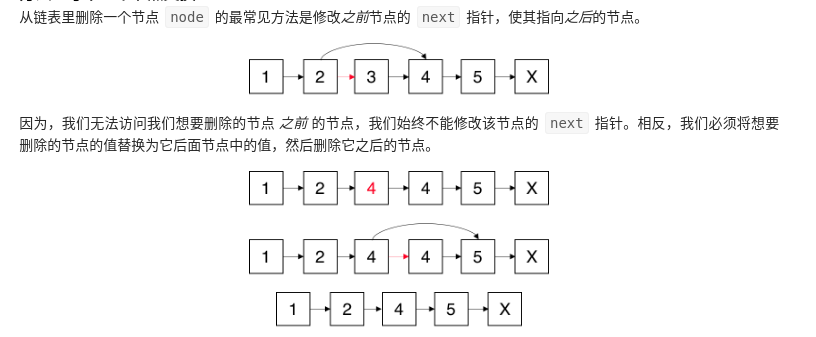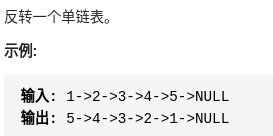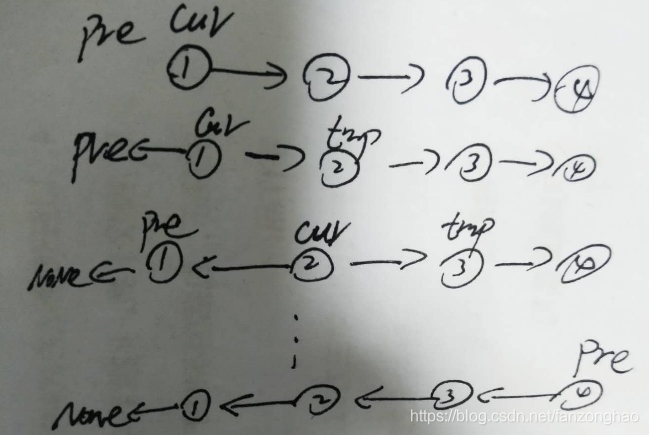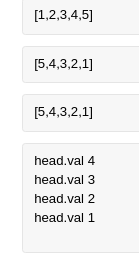主要常见下面几个知识点:

1-1.请编写一个函数,使其可以删除某个链表中给定的(非末尾)节点,你将只被给定要求被删除的节点。

python:
# Definition for singly-linked list.
# class ListNode:
# def __init__(self, x):
# self.val = x
# self.next = None
class Solution:
def deleteNode(self, node):
"""
:type node: ListNode
:rtype: void Do not return anything, modify node in-place instead.
"""
node.val = node.next.val
node.next = node.next.nextc++实现:
/**
* Definition for singly-linked list.
* struct ListNode {
* int val;
* ListNode *next;
* ListNode(int x) : val(x), next(NULL) {}
* };
*/
class Solution {
public:
void deleteNode(ListNode* node) {
node->val = node->next->val;
node->next = node->next->next;
}
};
通过将结点的值与它之后的结点进行比较来确定它是否为重复结点。如果它是重复的,我们更改当前结点的 next 指针,以便它跳过下一个结点并直接指向下一个结点之后的结点。如果不是重复的,则节点进行下移。
# Definition for singly-linked list.
# class ListNode:
# def __init__(self, x):
# self.val = x
# self.next = None
class Solution:
def deleteDuplicates(self, head: ListNode) -> ListNode:
node = head
while node and node.next:
if node.val == node.next.val:
node.next = node.next.next
else:
node = node.next
return head
c++实现:
/**
* Definition for singly-linked list.
* struct ListNode {
* int val;
* ListNode *next;
* ListNode() : val(0), next(nullptr) {}
* ListNode(int x) : val(x), next(nullptr) {}
* ListNode(int x, ListNode *next) : val(x), next(next) {}
* };
*/
class Solution {
public:
ListNode* deleteDuplicates(ListNode* head) {
ListNode* node = head;
while(node !=nullptr && node->next !=nullptr){
if(node->val == node->next->val){
node->next = node->next->next;
}
else
{
node = node->next;
}
}
return head;
}
};
思路:找到链表长度,通过在头结点补充一个节点找到要删除的节点的上一个节点,然后在进行删除
方法1:循环
# Definition for singly-linked list.
# class ListNode:
# def __init__(self, val=0, next=None):
# self.val = val
# self.next = next
class Solution:
def removeNthFromEnd(self, head: ListNode, n: int) -> ListNode:
length = 0
node = head
#获取链表长度
while node:
length+=1
node= node.next
# print(length)
curr_length = 0
new_head = ListNode(0)
new_head.next = head
node2=new_head
stop_length = length - n
#循环走到要删除节点的前一个节点
while stop_length:
stop_length-=1
node2 = node2.next
#跳过要删除的节点即可
node2.next = node2.next.next
return new_head.next
方法2:递归
# Definition for singly-linked list.
# class ListNode:
# def __init__(self, val=0, next=None):
# self.val = val
# self.next = next
class Solution:
def __init__(self):
self.count = 0
def removeNthFromEnd(self, head: ListNode, n: int) -> ListNode:
if not head:
return head
head.next = self.removeNthFromEnd(head.next, n) # 递归调用
self.count += 1 # 回溯时进行节点计数
return head.next if self.count == n else head
方法3:双指针
fist 指针与second指针相隔n,这样first跑到尾部,second的下一个节点就是倒数第n个

# Definition for singly-linked list.
# class ListNode:
# def __init__(self, val=0, next=None):
# self.val = val
# self.next = next
class Solution:
# def __init__(self):
# self.count = 0
def removeNthFromEnd(self, head: ListNode, n: int) -> ListNode:
new_head = ListNode(0)
new_head.next = head
first = head
second = new_head
for i in range(n):
first = first.next
while first:
first = first.next
second = second.next
second.next = second.next.next
return new_head.nextc++实现:
/**
* Definition for singly-linked list.
* struct ListNode {
* int val;
* ListNode *next;
* ListNode() : val(0), next(nullptr) {}
* ListNode(int x) : val(x), next(nullptr) {}
* ListNode(int x, ListNode *next) : val(x), next(next) {}
* };
*/
class Solution {
public:
ListNode* removeNthFromEnd(ListNode* head, int n) {
ListNode* new_head = new ListNode(0);
new_head ->next = head;
ListNode* first = head;
ListNode* second = new_head;
for(int i=0;i<n;i++){
first = first->next;
}
while(first){
first = first->next;
second = second->next;
}
second->next = second->next->next;
return new_head->next;
}
};1-4. 删除链表的节点

思路:双指针
# Definition for singly-linked list.
# class ListNode:
# def __init__(self, x):
# self.val = x
# self.next = None
class Solution:
def deleteNode(self, head: ListNode, val: int) -> ListNode:
if head is None:
return head
new_head = ListNode(0)
new_head.next = head
pre = new_head
cur = head
while cur.val != val:
pre = cur
cur = cur.next
pre.next = cur.next
return new_head.nextc++实现:
/**
* Definition for singly-linked list.
* struct ListNode {
* int val;
* ListNode *next;
* ListNode(int x) : val(x), next(NULL) {}
* };
*/
class Solution {
public:
ListNode* deleteNode(ListNode* head, int val) {
if(head == NULL){
return NULL;
}
ListNode* new_head = new ListNode(0);
new_head->next = head;
ListNode* pre = new_head;
ListNode* cur = head;
while(cur->val != val){
pre = cur;
cur = cur->next;
}
pre->next = cur->next;
return new_head->next;
}
};1-5.两两交换链表中的节点

思路:迭代法

python代码:
# Definition for singly-linked list.
# class ListNode:
# def __init__(self, val=0, next=None):
# self.val = val
# self.next = next
class Solution:
def swapPairs(self, head: ListNode) -> ListNode:
new_head = ListNode(0)
new_head.next = head
temp = new_head
while temp.next and temp.next.next:
node1 = temp.next
node2 = temp.next.next
temp.next = node2
node1.next = node2.next
node2.next = node1
temp = node1
return new_head.nextc++实现:
/**
* Definition for singly-linked list.
* struct ListNode {
* int val;
* ListNode *next;
* ListNode() : val(0), next(nullptr) {}
* ListNode(int x) : val(x), next(nullptr) {}
* ListNode(int x, ListNode *next) : val(x), next(next) {}
* };
*/
class Solution {
public:
ListNode* swapPairs(ListNode* head) {
ListNode* new_head = new ListNode(0);
new_head->next = head;
ListNode* temp = new_head;
while(temp->next && temp->next->next){
ListNode* head1 = temp->next;
ListNode* head2 = temp->next->next;
temp->next = head2;
head1->next = head2->next;
head2->next = head1;
temp = head1;
}
return new_head->next;
}
};2-1.反转链表

思路1:双指针

class Solution(object):
def reverseList(self, head):
"""
:type head: ListNode
:rtype: ListNode
"""
# 申请两个节点,pre和 cur,pre指向None
pre = None
cur = head
# 遍历链表,while循环里面的内容其实可以写成一行
while cur:
# 记录当前节点的下一个节点
tmp = cur.next
# 然后将当前节点指向pre
cur.next = pre
# pre和cur节点都前进一位
pre = cur
cur = tmp
return pre c++实现:
/**
* Definition for singly-linked list.
* struct ListNode {
* int val;
* ListNode *next;
* ListNode() : val(0), next(nullptr) {}
* ListNode(int x) : val(x), next(nullptr) {}
* ListNode(int x, ListNode *next) : val(x), next(next) {}
* };
*/
class Solution {
public:
ListNode* reverseList(ListNode* head) {
ListNode* pre = nullptr;
ListNode* temp = head;
while(head){
temp = head->next;
head->next = pre;
pre = head;
head = temp;
}
return pre;
}
};思路2.递归法
# Definition for singly-linked list.
# class ListNode:
# def __init__(self, x):
# self.val = x
# self.next = None
class Solution:
def reverseList(self, head: ListNode) -> ListNode:
# pre = None
# cur = head
# while cur:
# node = cur.next
# cur.next = pre
# pre = cur
# cur = node
# return pre
if head is None or head.next is None:
return head
new_node = self.reverseList(head.next)
print('head.val',head.val)
head.next.next = head
head.next = None
return new_node

2-2:旋转链表

思路:
构成循环列表以后 找到移动的节点 在拆分

python:
# Definition for singly-linked list.
# class ListNode:
# def __init__(self, val=0, next=None):
# self.val = val
# self.next = next
class Solution:
def rotateRight(self, head: ListNode, k: int) -> ListNode:
if k == 0 or head is None or head.next is None:
return head
#计算链表长度
cur = head
n = 1
while cur.next:
cur = cur.next
n += 1
# print('==n:', n)
add = n - k % n
if add == n:#k是n的整数倍直接返回原节点
return head
cur.next = head #构成环
while add:
cur = cur.next
add -= 1
new_head = cur.next#找到移动后的开始节点
cur.next = None#拆开
return new_headc++实现:
/**
* Definition for singly-linked list.
* struct ListNode {
* int val;
* ListNode *next;
* ListNode() : val(0), next(nullptr) {}
* ListNode(int x) : val(x), next(nullptr) {}
* ListNode(int x, ListNode *next) : val(x), next(next) {}
* };
*/
class Solution {
public:
ListNode* rotateRight(ListNode* head, int k) {
if(k == 0 || head == nullptr || head->next == nullptr){
return head;
}
int n = 1;//得到环长度
ListNode* cur = head;
while(cur->next){
cur = cur->next;
n++;
}
//找到移动的add长度
int add = n - k % n;
if(add == n){
return head;
}
cur->next = head;//构成环
while(add){
cur = cur->next;
add--;
}
ListNode* new_node = cur->next;
cur->next = nullptr;//拆环
return new_node;
}
};3-1.合并两个排序的链表

思路:引入一个指针头 python实现
# Definition for singly-linked list.
# class ListNode:
# def __init__(self, x):
# self.val = x
# self.next = None
class Solution:
def mergeTwoLists(self, l1: ListNode, l2: ListNode) -> ListNode:
head = ListNode(0)
node = head
while l1 and l2:
if l1.val < l2.val:
node.next = l1
l1 = l1.next
else:
node.next = l2
l2 = l2.next
node = node.next
if l1 is not None:
node.next= l1
if l2 is not None:
node.next= l2
return head.nextc++实现:
/**
* Definition for singly-linked list.
* struct ListNode {
* int val;
* ListNode *next;
* ListNode(int x) : val(x), next(NULL) {}
* };
*/
class Solution {
public:
ListNode* mergeTwoLists(ListNode* l1, ListNode* l2) {
ListNode* new_head = new ListNode(0);
ListNode* node = new_head;
while(l1!=NULL && l2 !=NULL){
if(l1->val<l2->val){
node->next = l1;
l1 = l1->next;
}
else{
node->next = l2;
l2 = l2->next;
}
node = node->next;
}
if (l1!=NULL){
node->next = l1;
}
if(l2!=NULL){
node->next = l2;
}
return new_head->next;
}
};3-2.合并K个升序链表

思路1:上一题合并两个变成for循环顺序合并
# Definition for singly-linked list.
# class ListNode:
# def __init__(self, val=0, next=None):
# self.val = val
# self.next = next
class Solution:
def mergeTwo(self, l1, l2):
if l1 is None:
return l2
if l2 is None:
return l1
head = ListNode(0)
node = head
while l1 and l2:
if l1.val <l2.val:
node.next = l1
l1 = l1.next
else:
node.next = l2
l2 = l2.next
node = node.next
if l1:
node.next = l1
if l2:
node.next = l2
return head.next
def mergeKLists(self, lists: List[ListNode]) -> ListNode:
ans = None
for i in range(len(lists)):
ans = self.mergeTwo(ans,lists[i])
return ansc++:
/**
* Definition for singly-linked list.
* struct ListNode {
* int val;
* ListNode *next;
* ListNode() : val(0), next(nullptr) {}
* ListNode(int x) : val(x), next(nullptr) {}
* ListNode(int x, ListNode *next) : val(x), next(next) {}
* };
*/
class Solution {
public:
ListNode* mergtwo(ListNode* l1, ListNode* l2){
if(l1==nullptr){
return l2;
}
if(l2==nullptr){
return l1;
}
ListNode* new_head= new ListNode(0);
ListNode* node = new_head;
while(l1 && l2){
if(l1->val<l2->val){
node->next = l1;
l1= l1->next;
}
else{
node->next = l2;
l2= l2->next;
}
node = node->next;
}
if(l1){
node->next = l1;
}
if(l2){
node->next = l2;
}
return new_head->next;
}
ListNode* mergeKLists(vector<ListNode*>& lists) {
ListNode* res = nullptr;
for (int i=0;i<lists.size();i++){
res = mergtwo(res,lists[i]);
}
return res;
}
};思路2:分治归并1
# Definition for singly-linked list.
# class ListNode:
# def __init__(self, val=0, next=None):
# self.val = val
# self.next = next
class Solution:
def mergeTwo(self, l1, l2):
if l1 is None:
return l2
if l2 is None:
return l1
head = ListNode(0)
node = head
while l1 and l2:
if l1.val <l2.val:
node.next = l1
l1 = l1.next
else:
node.next = l2
l2 = l2.next
node = node.next
if l1:
node.next = l1
if l2:
node.next = l2
return head.next
def mergeSort(self, lists, left, right):
if left==right:
return lists[left]
middle = left + (right-left)//2
# print('== middle:', middle)
l1 = self.mergeSort(lists,left,middle)
# print('== l1:', l1)
l2 = self.mergeSort(lists,middle+1,right)
return self.mergeTwo(l1, l2)
def mergeKLists(self, lists: List[ListNode]) -> ListNode:
# print('==hahah')
if len(lists)==0:
return None
return self.mergeSort(lists,0,len(lists) - 1)c++实现:
/**
* Definition for singly-linked list.
* struct ListNode {
* int val;
* ListNode *next;
* ListNode() : val(0), next(nullptr) {}
* ListNode(int x) : val(x), next(nullptr) {}
* ListNode(int x, ListNode *next) : val(x), next(next) {}
* };
*/
class Solution {
public:
ListNode* mergetwo(ListNode* l1, ListNode* l2){
if(l1==nullptr){
return l2;
}
if(l2==nullptr){
return l1;
}
ListNode* new_head= new ListNode(0);
ListNode* node = new_head;
while(l1 && l2){
if(l1->val<l2->val){
node->next = l1;
l1= l1->next;
}
else{
node->next = l2;
l2= l2->next;
}
node = node->next;
}
if(l1){
node->next = l1;
}
if(l2){
node->next = l2;
}
return new_head->next;
}
ListNode* mergesort(vector<ListNode*>& lists,int left, int right){
if(left==right){
return lists[left];
}
int middle = left+(right -left)/2;
ListNode* l1 = mergesort(lists,left,middle);
ListNode* l2 = mergesort(lists,middle+1,right);
return mergetwo(l1,l2);
}
ListNode* mergeKLists(vector<ListNode*>& lists) {
// ListNode* res = nullptr;
// for (int i=0;i<lists.size();i++){
// res = mergtwo(res,lists[i]);
// }
// return res;
if (lists.size()==0){
return nullptr;
}
return mergesort(lists,0,lists.size()-1);
}
};思路3:分支归并2 参考排序算法的归并排序 https://blog.csdn.net/fanzonghao/article/details/81270601
class Solution:
def mergeTwo(self, l1, l2):
if l1 is None:
return l2
if l2 is None:
return l1
head = ListNode(0)
node = head
while l1 and l2:
if l1.val < l2.val:
node.next = l1
l1 = l1.next
else:
node.next = l2
l2 = l2.next
node = node.next
if l1:
node.next = l1
if l2:
node.next = l2
return head.next
def mergeSort(self, L):
if len(L) <= 1:
return L[0]
mid = len(L) // 2
l1 = self.mergeSort(L[:mid])
l2 = self.mergeSort(L[mid:])
return self.mergeTwo(l1, l2)
def mergeKLists(self, lists: List[ListNode]) -> ListNode:
if len(lists)==0:
return None
return self.mergeSort(lists)
思路:递归 终止条件就是节点为None.

1.递归法
# Definition for singly-linked list.
# class ListNode:
# def __init__(self, val=0, next=None):
# self.val = val
# self.next = next
class Solution:
def mergeTwoLists(self, l1: ListNode, l2: ListNode) -> ListNode:
#递归的终止条件
if l1 is None:
return l2
elif l2 is None:
return l1
elif l1.val < l2.val:
l1.next = self.mergeTwoLists(l1.next,l2)
return l1
else:
l2.next = self.mergeTwoLists(l1,l2.next)
return l2
2.迭代法:
# Definition for singly-linked list.
# class ListNode:
# def __init__(self, x):
# self.val = x
# self.next = None
class Solution:
def mergeTwoLists(self, l1: ListNode, l2: ListNode) -> ListNode:
fake_head_node = ListNode(0)
cur = fake_head_node
while l1 and l2:
if l1.val<l2.val:
cur.next = l1
l1 = l1.next
else:
cur.next = l2
l2 = l2.next
cur = cur.next
if l1:
cur.next = l1
else:
cur.next = l2
return fake_head_node.next
3-4.排序链表

思路1:归并排序 先通过快慢指针找到中心点 进行截断以后一直递归拆开 在进行合并即可
python代码:
# Definition for singly-linked list.
# class ListNode:
# def __init__(self, val=0, next=None):
# self.val = val
# self.next = next
class Solution:
def merge(self, left, right):
res = ListNode(0)
temp = res
while left and right:
if left.val < right.val:
temp.next, left = left, left.next
else:
temp.next, right = right, right.next
temp = temp.next
temp.next = left if left else right
return res.next
def sortList(self, head: ListNode) -> ListNode:
if head is None or head.next is None:
return head
#快慢指针找到链表中心点
slow, fast = head, head.next
while fast and fast.next:
fast, slow = fast.next.next, slow.next
mid, slow.next = slow.next, None#将找到的中心点进行截断故 slow.next = None
left, right = self.sortList(head), self.sortList(mid)#递归一直进行拆分
return self.merge(left, right)#合并操作
c++代码:
/**
* Definition for singly-linked list.
* struct ListNode {
* int val;
* ListNode *next;
* ListNode() : val(0), next(nullptr) {}
* ListNode(int x) : val(x), next(nullptr) {}
* ListNode(int x, ListNode *next) : val(x), next(next) {}
* };
*/
class Solution {
public:
ListNode* mergetwo(ListNode* l1,ListNode* l2){
ListNode* new_head = new ListNode(0);
ListNode* node = new_head;
while(l1 && l2){
if(l1->val<l2->val){
node->next = l1;
l1 = l1->next;
}
else{
node->next = l2;
l2 = l2->next;
}
node = node->next;
}
if(l1){
node->next = l1;
}
if(l2){
node->next = l2;
}
return new_head->next;
}
ListNode* sortList(ListNode* head) {
if(head==nullptr || head->next==nullptr){
return head;
}
ListNode* slow = head;
ListNode* fast = head->next;
while(fast && fast->next){
slow = slow->next;
fast = fast->next->next;
}
ListNode* middle = slow->next;
slow->next = nullptr;
ListNode* l1 = sortList(head);
ListNode* l2 = sortList(middle);
return mergetwo(l1,l2);
}
};思路2:合并也是递归
# Definition for singly-linked list.
# class ListNode:
# def __init__(self, val=0, next=None):
# self.val = val
# self.next = next
class Solution:
# def merge(self, left, right):
# res = ListNode(0)
# temp = res
# while left and right:
# if left.val < right.val:
# temp.next, left = left, left.next
# else:
# temp.next, right = right, right.next
# temp = temp.next
# temp.next = left if left else right
# return res.next
def merge(self,left,right):
if left is None:
return right
if right is None:
return left
if left.val < right.val:
left.next = self.merge(left.next, right)
return left
else:
right.next = self.merge(left, right.next)
return right
def sortList(self, head: ListNode) -> ListNode:
if head is None or head.next is None:
return head
#快慢指针找到链表中心点
slow, fast = head, head.next
while fast and fast.next:
fast, slow = fast.next.next, slow.next
mid, slow.next = slow.next, None#将找到的中心点进行截断故 slow.next = None
left, right = self.sortList(head), self.sortList(mid)#递归一直进行拆分
return self.merge(left, right)#合并操作
3-5.两数相加

思路:开出一个head头,利用一个指针进行遍历,需要注意的是进位
# Definition for singly-linked list.
# class ListNode:
# def __init__(self, val=0, next=None):
# self.val = val
# self.next = next
class Solution:
def addTwoNumbers(self, l1: ListNode, l2: ListNode) -> ListNode:
head = ListNode(0)
new_node = head
carry = 0
while l1 and l2:
new_node.next =ListNode(l1.val+l2.val+carry)
carry = new_node.next.val//10
new_node.next.val = new_node.next.val%10
l1 = l1.next
l2= l2.next
new_node = new_node.next
# print(carry)
while l1:
new_node.next = ListNode(l1.val+carry)
carry = new_node.next.val//10
new_node.next.val = new_node.next.val%10
l1 = l1.next
new_node = new_node.next
while l2:
new_node.next = ListNode(l2.val+carry)
carry = new_node.next.val//10
new_node.next.val = new_node.next.val%10
l2 = l2.next
new_node = new_node.next
if carry:
new_node.next = ListNode(carry)
return head.nextc++实现:
/**
* Definition for singly-linked list.
* struct ListNode {
* int val;
* ListNode *next;
* ListNode() : val(0), next(nullptr) {}
* ListNode(int x) : val(x), next(nullptr) {}
* ListNode(int x, ListNode *next) : val(x), next(next) {}
* };
*/
class Solution {
public:
ListNode* addTwoNumbers(ListNode* l1, ListNode* l2) {
ListNode* head = new ListNode(0);
ListNode* new_head = head;
int carry = 0;
while(l1 && l2){
new_head->next = new ListNode(l1->val + l2->val + carry);
carry = new_head->next->val/10;
new_head->next->val = new_head->next->val%10;
new_head = new_head->next;
l1 = l1->next;
l2 = l2->next;
}
while(l1){
new_head->next = new ListNode(l1->val + carry);
carry = new_head->next->val/10;
new_head->next->val = new_head->next->val%10;
new_head = new_head->next;
l1 = l1->next;
}
while(l2){
new_head->next = new ListNode(l2->val + carry);
carry = new_head->next->val/10;
new_head->next->val = new_head->next->val%10;
new_head = new_head->next;
l2 = l2->next;
}
if(carry){
new_head->next = new ListNode(carry);
}
return head->next;
}
};
# Definition for singly-linked list.
# class ListNode:
# def __init__(self, x):
# self.val = x
# self.next = None
class Solution:
def hasCycle(self, head: ListNode) -> bool:
#快慢指针 人追人
slow,fast = head,head
while fast:
if fast and fast.next:
slow = slow.next
fast=fast.next.next
else:
return False
if slow==fast:
return True
return Falsec++实现:
/**
* Definition for singly-linked list.
* struct ListNode {
* int val;
* ListNode *next;
* ListNode(int x) : val(x), next(NULL) {}
* };
*/
class Solution {
public:
bool hasCycle(ListNode *head) {
ListNode* slow = head;
ListNode* fast = head;
while(fast){
if(fast && fast->next){
slow = slow->next;
fast = fast->next->next;
}
else{
return false;
}
if(slow==fast){
return true;
}
}
return false;
}
};
假设有两个指针,分别为快慢指针fast和slow, 快指针每次走两步,慢指针每次前进一步,如果有环则两个指针必定相遇;
反证法:假设快指针真的 越过 了慢指针,且快指针处于位置 i+1,而慢指针处于位置 i,那么在前一步,快指针处于位置 i-1,慢指针也处于位置 i-1,它们相遇了。
A:链表起点
B:环起点
C:相遇点
X:环起点到相遇点距离
Y:链表起点到环起点距离
R:环的长度
S:第一次相遇时走过的路程
1.慢指针slow第一次相遇走过的路程 S1 = Y + X;(11)
快指针fast第一次相遇走过的路程 S2=2S1 = Y + X + NR;(2)
说明:快指针的速度是慢指针的两倍,相同时间内路程应该是慢指针的两倍,Y + X + NR是因为快指针可能经过N圈后两者才相遇;
把(1)式代入(2)式得:Y = NR -X;
2..在将慢指针回到A点,满指针和快指针同时走,在B点相遇,此处就是环节点.
# Definition for singly-linked list.
# class ListNode:
# def __init__(self, x):
# self.val = x
# self.next = None
class Solution:
def detectCycle(self, head: ListNode) -> ListNode:
slow = head
fast = head;
while fast:
if fast and fast.next:
slow = slow.next
fast = fast.next.next
else:
return None
if slow==fast:
break
if fast ==None or fast.next==None:
return None
slow= head
while slow!=fast:
slow = slow.next
fast = fast.next
return slowc++实现:
/**
* Definition for singly-linked list.
* struct ListNode {
* int val;
* ListNode *next;
* ListNode(int x) : val(x), next(NULL) {}
* };
*/
class Solution {
public:
ListNode *detectCycle(ListNode *head) {
ListNode* slow = head;
ListNode* fast = head;
while(fast){
if(fast && fast->next){
slow = slow->next;
fast = fast->next->next;
}
else{
return NULL;
}
if(slow==fast){
break;
}
}
if(!fast || !fast->next){
return NULL;
}
slow = head;
while(slow!=fast){
slow = slow->next;
fast = fast->next;
}
return slow;
}
};4-3.链表相交

如这题应该是比较明显的双指针题,要是能实现一种算法让两个指针分别从A和B点往C点走,两个指针分别走到C后,又各自从另外一个指针的起点,也就是A指针第二次走从B点开始走,B指针同理,这样,A指针走的路径长度 AO + OC + BO 必定等于B指针走的路径长度 BO + OC + AO,这也就意味着这两个指针第二轮走必定会在O点相遇,相遇后也即到达了退出循环的条件,代码如下:
# Definition for singly-linked list.
# class ListNode:
# def __init__(self, x):
# self.val = x
# self.next = None
class Solution:
def getIntersectionNode(self, headA: ListNode, headB: ListNode) -> ListNode:
index_a = headA
index_b = headB
while index_a !=index_b:
if index_a !=None:
index_a = index_a.next
else:
index_a = headB
if index_b != None:
index_b = index_b.next
else:
index_b = headA
return index_a
c++实现:
/**
* Definition for singly-linked list.
* struct ListNode {
* int val;
* ListNode *next;
* ListNode(int x) : val(x), next(NULL) {}
* };
*/
class Solution {
public:
ListNode *getIntersectionNode(ListNode *headA, ListNode *headB) {
ListNode* node_A = headA;
ListNode* node_B = headB;
while(node_A!=node_B){
if(node_A!=NULL){
node_A=node_A->next;
}
else{
node_A = headB;
}
if(node_B!=NULL){
node_B=node_B->next;
}
else{
node_B = headA;
}
}
return node_A;
}
};4-4.两个链表的第一个公共节点

思路:双指针 两个指针轮流走一遍各自的路程,这样相遇就是公共节点,对于没有公共节点的情况,所以需要判断自身节点不是none,而不是.next是none,在去交换指针,否则会陷入无穷循环,而此时输出就是none。
python
# Definition for singly-linked list.
# class ListNode:
# def __init__(self, x):
# self.val = x
# self.next = None
class Solution:
def getIntersectionNode(self, headA: ListNode, headB: ListNode) -> ListNode:
first_head = headA
second_head = headB
while first_head !=second_head:
if first_head is not None:
first_head = first_head.next
else:
first_head = headB
if second_head is not None:
second_head = second_head.next
else:
second_head = headA
# print(first_head)
return first_headc++:
/**
* Definition for singly-linked list.
* struct ListNode {
* int val;
* ListNode *next;
* ListNode(int x) : val(x), next(NULL) {}
* };
*/
class Solution {
public:
ListNode *getIntersectionNode(ListNode *headA, ListNode *headB) {
ListNode *first_node;
first_node = headA;
ListNode *second_node;
second_node= headB;
while(first_node != second_node)
{
if(first_node !=NULL)
{
first_node = first_node->next;
}
else
{
first_node = headB;
}
if(second_node !=NULL)
{
second_node = second_node->next;
}
else
{
second_node = headA;
}
}
return first_node;
}
};5-1.输入一个链表的头节点,从尾到头反过来返回每个节点的值(用数组返回)。
1.借用栈
# Definition for singly-linked list.
# class ListNode:
# def __init__(self, x):
# self.val = x
# self.next = None
class Solution:
def reversePrint(self, head: ListNode) -> List[int]:
stack = []
while head:
stack.append(head.val)
head = head.next
return stack[::-1]c++:
/**
* Definition for singly-linked list.
* struct ListNode {
* int val;
* ListNode *next;
* ListNode(int x) : val(x), next(NULL) {}
* };
*/
class Solution {
public:
vector<int> reversePrint(ListNode* head) {
vector<int> res;
while(head){
res.push_back(head->val);
head = head->next;
}
reverse(res.begin(),res.end());
return res;
}
};2.递归回溯
# Definition for singly-linked list.
# class ListNode:
# def __init__(self, x):
# self.val = x
# self.next = None
class Solution:
def reversePrint(self, head: ListNode) -> List[int]:
if head:
return self.reversePrint(head.next)+[head.val]
else:
return []利用列表将列表值进行拷贝,在判断是否是回文字符串
# Definition for singly-linked list.
# class ListNode:
# def __init__(self, x):
# self.val = x
# self.next = None
class Solution:
def isPalindrome(self, head: ListNode) -> bool:
stack= []
while head:
stack.append(head.val)
head = head.next
return stack==stack[::-1]c++实现:
/**
* Definition for singly-linked list.
* struct ListNode {
* int val;
* ListNode *next;
* ListNode() : val(0), next(nullptr) {}
* ListNode(int x) : val(x), next(nullptr) {}
* ListNode(int x, ListNode *next) : val(x), next(next) {}
* };
*/
class Solution {
public:
bool isPalindrome(ListNode* head) {
vector<int> res;
while(head){
res.push_back(head->val);
head = head->next;
}
int left=0;
int right=res.size()-1;
while(left<right){
if(res[left]==res[right]){
left+=1;
right-=1;
}
else{
return false;
}
}
return true;
}
};5-3.分隔链表

思路:开出两个大小节点,用于指向大于x和小于x的,遍历结束以后在合并即可
# Definition for singly-linked list.
# class ListNode:
# def __init__(self, x):
# self.val = x
# self.next = None
class Solution:
def partition(self, head: ListNode, x: int) -> ListNode:
small_head = ListNode(0)
large_head = ListNode(0)
small_node = small_head
large_node = large_head
while head:
if head.val < x:
small_node.next = head
small_node = small_node.next
else:
large_node.next = head
large_node = large_node.next
head= head.next
large_node.next = None
small_node.next = large_head.next
return small_head.nextc++写法:
/**
* Definition for singly-linked list.
* struct ListNode {
* int val;
* ListNode *next;
* ListNode() : val(0), next(nullptr) {}
* ListNode(int x) : val(x), next(nullptr) {}
* ListNode(int x, ListNode *next) : val(x), next(next) {}
* };
*/
class Solution {
public:
ListNode* partition(ListNode* head, int x) {
ListNode* small_head = new ListNode(0);
ListNode* big_head = new ListNode(0);
ListNode* small_node =small_head;
ListNode* big_node = big_head;
while(head){
if (head->val<x){
small_node->next = head;
small_node = small_node->next;
}
else{
big_node->next = head;
big_node = big_node->next;
}
head = head->next;
}
big_node->next = nullptr;
small_node->next = big_head->next;
return small_head->next;
}
};6-1.二叉树展开为链表

思路:可看出是根据前序遍历的节点统统放在右子树上
# Definition for a binary tree node.
# class TreeNode:
# def __init__(self, val=0, left=None, right=None):
# self.val = val
# self.left = left
# self.right = right
class Solution:
def help(self, node):
if node is not None:
self.res.append(node)
self.help(node.left)
self.help(node.right)
def flatten(self, root: TreeNode) -> None:
"""
Do not return anything, modify root in-place instead.
"""
self.res = []
self.help(root)
# print(self.res)
length = len(self.res)
for i in range(1,length):
pre,cur = self.res[i-1],self.res[i]
pre.left = None
pre.right = cur
return rootc++实现:
/**
* Definition for a binary tree node.
* struct TreeNode {
* int val;
* TreeNode *left;
* TreeNode *right;
* TreeNode() : val(0), left(nullptr), right(nullptr) {}
* TreeNode(int x) : val(x), left(nullptr), right(nullptr) {}
* TreeNode(int x, TreeNode *left, TreeNode *right) : val(x), left(left), right(right) {}
* };
*/
class Solution {
public:
vector<TreeNode* >res;
void help(TreeNode* node){
if(node){
res.push_back(node);
help(node->left);
help(node->right);
}
}
void flatten(TreeNode* root) {
help(root);
for(int i=1;i<res.size();i++){
TreeNode* pre = res[i-1];
TreeNode* cur = res[i];
pre->left = nullptr;
pre->right = cur;
}
// return root;
}
};